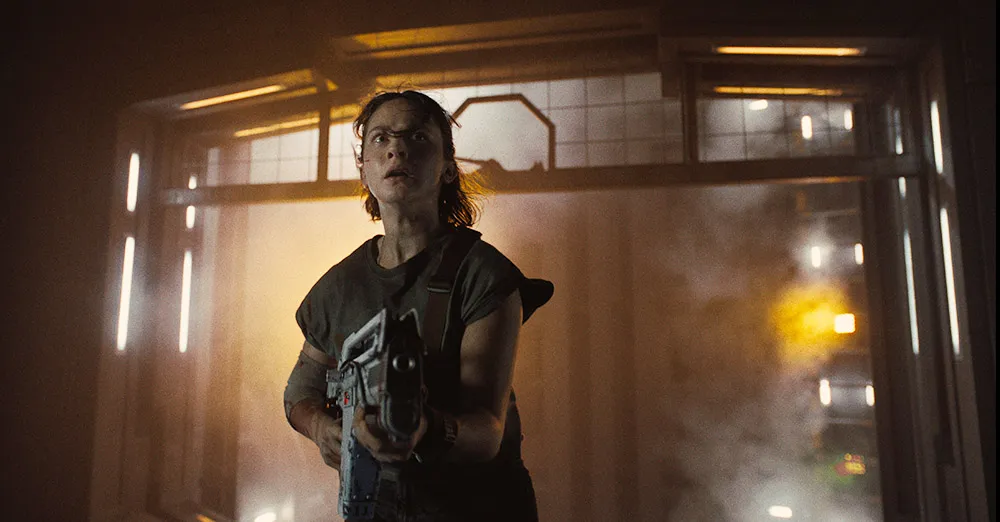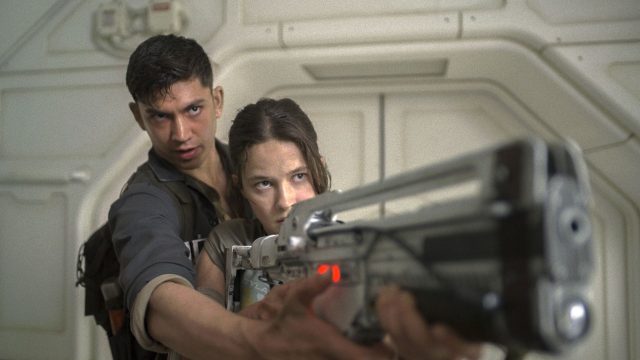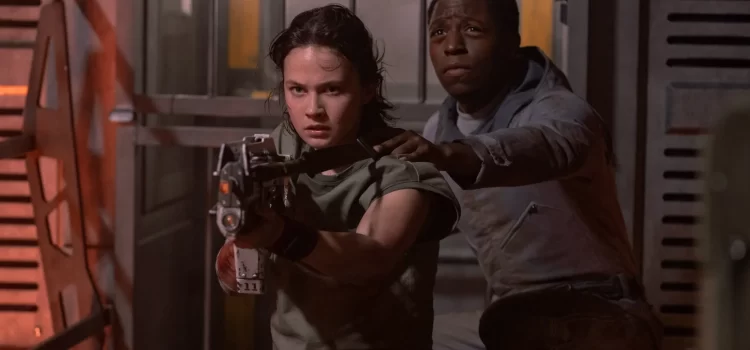By Lynn Venhaus
This is an “Alien” built on fan service, from its loop of greatest hits to recycling the original’s most famous lines to repurposing familiar tropes. Face huggers? Chest busters? You got it.
The “Romulus” sequel does feel aimed at young viewers new to the franchise, so if you are a longtime fan seeking something fresh and different, “Romulus” may disappoint.
Since Ridley Scott blazed a trail with his terrifying “Alien” science fiction-action-horror film in 1979, three sequels and two prequels have broadened the franchise built on space travelers’ suspenseful encounters with an extraterrestrial species.
These grotesque ooze-dripping creatures called “Xenomorphs” look like a large head atop a giant insect-reptile hybrid spin on the “Creature from the Black Lagoon,” and they remain as terrifying now as when the original just teased the look as the creepy invader of the Nostromo.
Fun fact: Swiss artist H.R. Giger known for his biomechanical style, created the adult form ‘Alien,’ inspired by his painting “Necronom IV,” and won an Oscar in 1980 for being part of the visual effects team.
The image is still the frightening gold standard. Director Fede Alvarez goes much bigger, ramping up the gore and the goo. He focuses on repetitive graphic depictions of these hostile lifeforms in all their stages of growth, multiplying them, showing their gnarly sharp teeth in close-ups and face-to-face encounters.
Scott returns as a producer, after directing two prequels “Prometheus” (2012) and “Alien: Covenant” (2017), handing off directing duties to Alvarez, who displayed strong horror-genre skills with “Don’t Breathe” (2016) and “Evil Dead” (2013), a remake of Sam Raimi’s classic 1981 film.

“Romulus” takes place between the original’s time and the 1986 sequel “Aliens,” so it’s about mid-22nd century. The story follows a grungy group of intergalactic colonists who want to raid a space station for valuables, but instead discover it is infested with hideous invasive creatures who begin hunting them. Blood spurts, body parts are severed, and the classic Agatha Christie template “And Then There Were None,” kicks into high gear.
Cinematographer Galo Olivares has created an atmosphere that is dystopian-future bleak, and everything’s grimy and dark – and claustrophobic. The young adults have been working at the Jackson Star Colony Mine, on a planet with no sunlight, and it’s a miserable prison-like existence. No wonder they want to escape for space travel.
You surmise as soon as they enter what they think is an abandoned out-of-service spaceship that it’s a bad idea, and most of these savvy techies/space cowboys will either become a host to the endoparasitoids, or shredded to smithereens, suffering elaborate grisly deaths.
While the visuals dominate, there isn’t much character depth in the screenplay by Alvarez and his “Don’t Breathe” writing partner Rodo Sayagues. Instead, they emphasize scare tactics and dangerous situations that the cast must either flee from or figure out a better way for survival.
The movie takes too long to set up, is confusing, and doesn’t quite know how to stick the landing. So, it’s hard to connect with any of them other than the two leads, Rain (Cailee Spaeny) and Andy (David Jonsson), a synthetic android she considers her brother.
The roles are physically demanding because everyone is in fight and flight mode 24/7 and running a lot. Aileen Wu is Navarro, Spike Fearn is her boyfriend Bjorn, Archie Renaux is Tyler and Isabela Merced is his younger sister Kay. Ian Holm, who was in the first movie as Ash, reappears here digitally as an android, but as Rook (note: Holm died in 2020).
In addition to the life-threatening creatures overwhelming the colonists, we are reminded that the megacorporation Weyland-Yutani Corporation is always up to no good. They care more about profits than people, and have been a manipulative villain thread through the series.

Spaeny, who made a splash last year as the title role in Sofia Coppola’s “Priscilla” and this year in “Civil War,” is in the Ellen Ripley mold of rising to the occasion and becoming the tough and determined heroine. Rain is resourceful, resilient, and compassionate – all the qualities that make for a good protagonist.
Jonsson, who played Gus in the HBO series “Industry,” has the more nuanced, difficult role, and he stands out as the most compelling – switching personalities from a docile, guileless, glitchy “synth” to a smart android who suspiciously knows more than he divulges.
The third act goes on for far too long, and even though the film is 2 hours, it feels longer. Just when you think it’s over, not so fast, and there is one plot twist that’s not just ridiculous, but disgusting and disturbing.
One of the film’s most admirable qualities is that, like “Godzilla Minus One,” they went old-school with the visual effects. Instead of making mostly a heavy green-screen movie, Alvarez employed members of the special effects crew from the 1986 “Aliens” to work on the creatures. They developed animatronics, miniatures and used ‘a guy in a suit’ wherever possible.
The Alien franchise has also spawned video games, a television show “Alien: Earth,” and a crossover series “Alien vs. Predator,” so its staying power is undeniable.
Buried underneath the repulsive monsters and the gruesome situations is a story that needed further investigation. It would have boosted the likability to provide character backstories, and not just rely on nostalgia for what’s gone on before as the driving force.
“Alien: Romulus” is a 2024 science fiction-actor-horror movie directed by Fede Alvarez and starring Caely Spaeny, David Jonsson, Archie Renaux, Spike Fearn, Isabela Merced, Aileen Wu and Ian Holm. It is rated R for bloody violent content and language, and the runtime is 1 hour, 59 minutes. It opened in theatres Aug. 16. Lynn’s Grade: D.


Lynn (Zipfel) Venhaus has had a continuous byline in St. Louis metro region publications since 1978. She writes features and news for Belleville News-Democrat and contributes to St. Louis magazine and other publications.
She is a Rotten Tomatoes-approved film critic, currently reviews films for Webster-Kirkwood Times and KTRS Radio, covers entertainment for PopLifeSTL.com and co-hosts podcast PopLifeSTL.com…Presents.
She is a member of Critics Choice Association, where she serves on the women’s and marketing committees; Alliance of Women Film Journalists; and on the board of the St. Louis Film Critics Association. She is a founding and board member of the St. Louis Theater Circle.
She is retired from teaching journalism/media as an adjunct college instructor.

